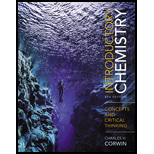
Concept explainers
(a)
Interpretation:
The boiling point of water on the given temperature scale is to be stated.
Concept introduction:
Temperature can be measured in Kelvin scale, Celsius scale and Fahrenheit scale. Celsius is the commonly used measurement unit for temperature. Kelvin is the SI unit of temperature.
(b)
Interpretation:
The boiling point of water on the given temperature scale is to be stated.
Concept introduction:
Temperature can be measured in Kelvin scale, Celsius scale and Fahrenheit scale. Celsius is the commonly used measurement unit for temperature. Kelvin is the SI unit of temperature.
(c)
Interpretation:
The boiling point of water on the given temperature scale is to be stated.
Concept introduction:
Temperature can be measured in Kelvin scale, Celsius scale and Fahrenheit scale. Celsius is the commonly used measurement unit for temperature. Kelvin is the SI unit of temperature.
Want to see the full answer?
Check out a sample textbook solution
Chapter 2 Solutions
Introductory Chemistry: Concepts and Critical Thinking Plus MasteringChemistry with eText -- Access Card Package
- Calculate the volume of 125g of the following liquids: a. Sea water (d=1.03g/mL) b. Methyl alcohol (d=0.792g/mL) c. Concentrated sulfuric acid (d=1.84g/mL)arrow_forwardWhich of the following is a liquid nonmetal under normal conditions: sodium, mercury, -bromine, or sulfur?arrow_forwardWhat is Volume in matter??arrow_forward
- What is the SI unit of volume? What is the other common unit which in notan SI unit of volume.arrow_forwardCalculate the volume of 125g of the following liquids: a. Acetone (d=0.792g/mL) b. Olive oil (d=0.918g/mL) c. Chloroform (d=1.49g/mL)arrow_forwardA bicycle accelerates from 5 miles per hour to 15 miles per hour. Does its energy increase or decrease? Is the change in potential energy or kinetic energy?arrow_forward
- Referring to Table 1.3, answer the following questions: a. Which is longer, a centimeter or an inch? b. How many milliliters are in a quart? c. How many grams are in an ounce?arrow_forwardWhich state of matter has a high density and an indefinite shape?arrow_forwardState the density of water in grams per milliliter.arrow_forward
 Chemistry for Today: General, Organic, and Bioche...ChemistryISBN:9781305960060Author:Spencer L. Seager, Michael R. Slabaugh, Maren S. HansenPublisher:Cengage Learning
Chemistry for Today: General, Organic, and Bioche...ChemistryISBN:9781305960060Author:Spencer L. Seager, Michael R. Slabaugh, Maren S. HansenPublisher:Cengage Learning World of Chemistry, 3rd editionChemistryISBN:9781133109655Author:Steven S. Zumdahl, Susan L. Zumdahl, Donald J. DeCostePublisher:Brooks / Cole / Cengage Learning
World of Chemistry, 3rd editionChemistryISBN:9781133109655Author:Steven S. Zumdahl, Susan L. Zumdahl, Donald J. DeCostePublisher:Brooks / Cole / Cengage Learning Introductory Chemistry: An Active Learning Approa...ChemistryISBN:9781305079250Author:Mark S. Cracolice, Ed PetersPublisher:Cengage Learning
Introductory Chemistry: An Active Learning Approa...ChemistryISBN:9781305079250Author:Mark S. Cracolice, Ed PetersPublisher:Cengage Learning



